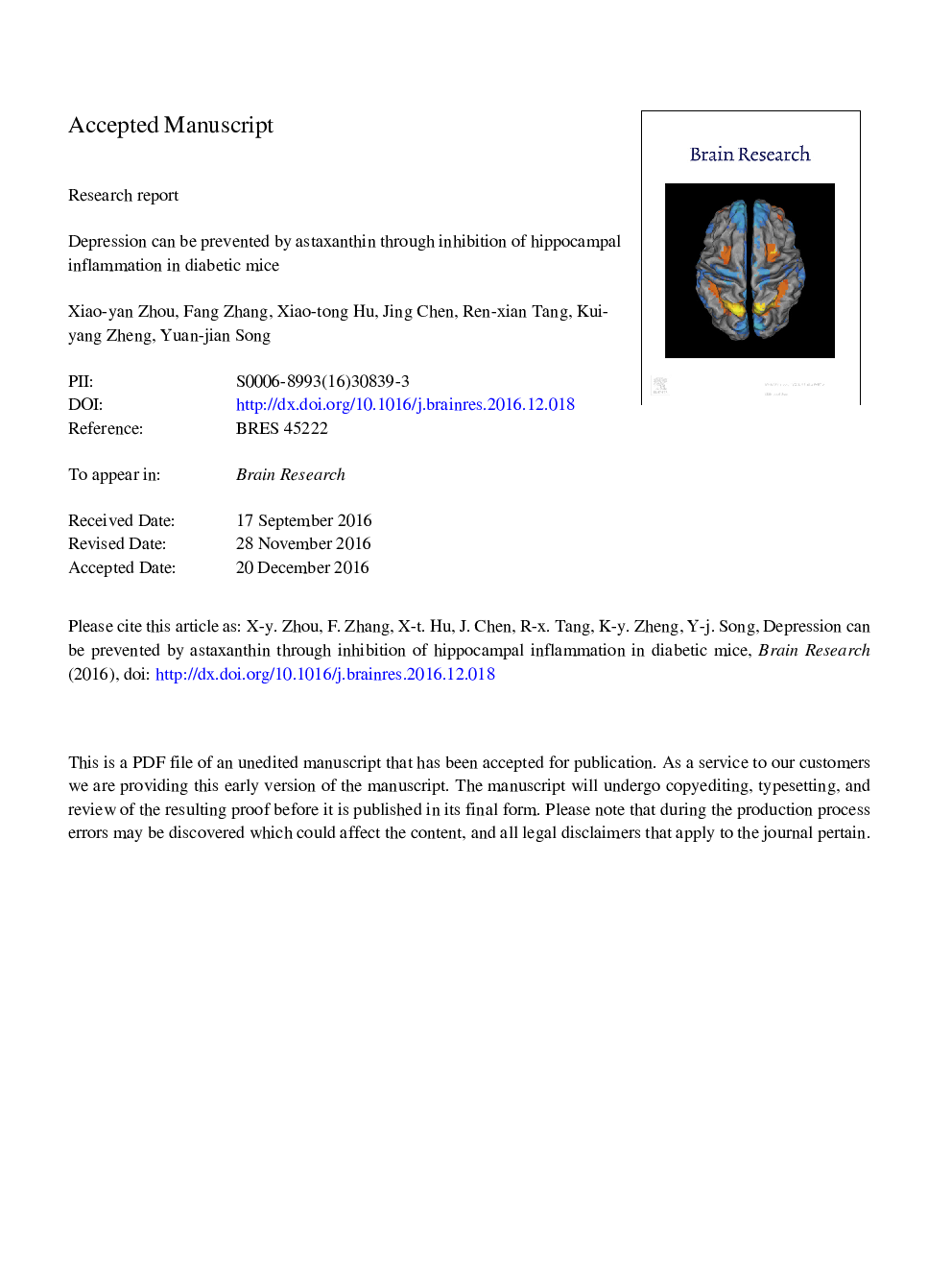| کد مقاله | کد نشریه | سال انتشار | مقاله انگلیسی | نسخه تمام متن |
|---|---|---|---|---|
| 5736562 | 1613788 | 2017 | 34 صفحه PDF | دانلود رایگان |
عنوان انگلیسی مقاله ISI
Depression can be prevented by astaxanthin through inhibition of hippocampal inflammation in diabetic mice
ترجمه فارسی عنوان
افسردگی می تواند توسط آساتکسانتین از طریق مهار التهاب هیپوکامپ در موش های دیابتی جلوگیری شود
دانلود مقاله + سفارش ترجمه
دانلود مقاله ISI انگلیسی
رایگان برای ایرانیان
کلمات کلیدی
استاتسانانت، افسردگی، دیابت، التهاب صدمه،
موضوعات مرتبط
علوم زیستی و بیوفناوری
علم عصب شناسی
علوم اعصاب (عمومی)
چکیده انگلیسی
The critical factor considered in a depression induced by diabetes is the inflammation eliciting hippocampal, amygdala and thalamic neuronal injury. Therefore, inhibiting inflammatory reactions in the brain and reducing neuronal injury can alleviate depression in rodents suffering from diabetes mellitus. The oral administration of astaxanthin has been employed in emotional disorders and diabetic complications due to its anti-depressant, anti-inflammatory and anti-apoptotic functions. However, it has not been reported whether astaxanthin can improve diabetes-related depression-like behavior, and its potential mechanisms have not been elucidated. The objective of the present study is to elucidate the effect of astaxanthin on depression in diabetic mice and to understand the underlying molecular mechanisms. In this study, experimental diabetic mice were given a single intraperitoneal injection of streptozotocin (STZ, 150 mg/kg, dissolved in citrate buffer) after fasting for 12 h. The diabetic model was assessed 72 h after STZ injection, and mice with a fasting blood glucose level more than or equal to 16.7 mmol/L were used in this study, and oral astaxanthin (25 mg/kg) was provided uninterrupted for ten weeks. Depression-like behavior was evaluated by the tail suspension test (TST) and forced swimming test (FST). The glial fibrillary acidic protein (GFAP) and cleaved caspase-3-positive cells were measured by immunohistochemistry, and the western blotting was used to test the protein levels of interleukin-6 (IL-6), interleukin-1β (IL-1β) and cyclooxygenase (COX-2). The results showed that astaxanthin had an anti-depressant effect on diabetic mice. Furthermore, we observed that astaxanthin significantly reduced the number of GFAP-positive cells in the hippocampus and hypothalamus, and also the expression of cleaved caspase-3 in the hippocampus, amygdala and hypothalamus was decreased as well. Moreover, astaxanthin could down-regulate the expression of IL-6, IL-1β and COX-2 in the hippocampus. These findings suggest that the mechanism of astaxanthin in preventing depression in diabetic mice involves the inhibition of inflammation/inflammation inhibition, thereby protecting neurons in hippocampus, amygdala and hypothalamus against hyperglycemic damage.
ناشر
Database: Elsevier - ScienceDirect (ساینس دایرکت)
Journal: Brain Research - Volume 1657, 15 February 2017, Pages 262-268
Journal: Brain Research - Volume 1657, 15 February 2017, Pages 262-268
نویسندگان
Xiao-yan Zhou, Fang Zhang, Xiao-tong Hu, Jing Chen, Ren-xian Tang, Kui-yang Zheng, Yuan-jian Song,
